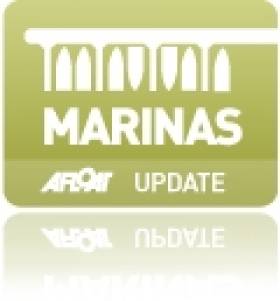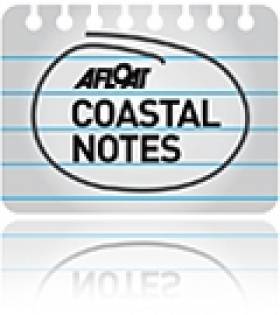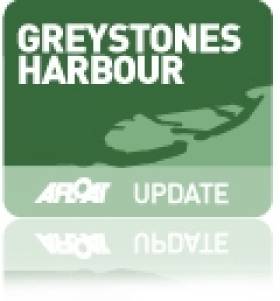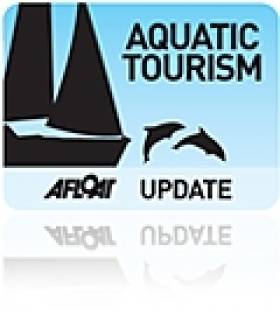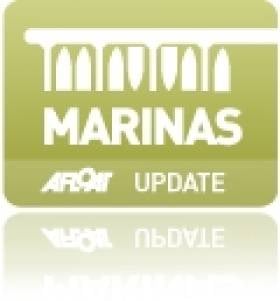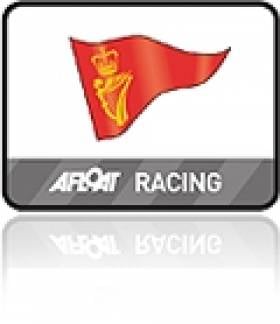Displaying items by tag: Marina
New Marina For Arklow, County Wicklow
#arklowberths –In a further boost for marine lesiure and the necklace of Irish marinas around the coast, the 'Garden County' has announced 20 new berths for Arklow Harbour. It's a bid, says Arklow Harbourmaster Paul Ivory, 'to generate tourism and providing additional berthing facilities for the Arklow area'.
Ivory expects the new facility, built by Irish firm Inland and Coastal, to open before the end of the year.
It's another berthing option that follows on the successful opening of the 200–berth Greystones Harbour Marina in April 2013.
Commissioning work is still taking place in Arklow (see pontoon layout above) and rates have yet to be calculated by Wicklow County Council, who now operate Arklow Harbour.
The Marina is located in the Dock at Arklow, which has been recently dredged to an average depth of 3.0m Chart Datum, acccording to Ivory.
The new pontoons have the following berth capacity; 4 x 10m vessels on 7.5m long berths and 16 x 12m vessels on 9m long berths.
Further details are as follows:
General:
− Wheelchair accessible gangway
− Rolec service pedestals for 16amp electricity supply with smart card metering
− Fresh water taps at each pedestal
− Safety ladders and lifebuoys fitted
− Security gate at gangway
− No toilet, shower or laundry services available yet
− Price of berths to be published soon
Technical:
− Built by Inland & Coastal Marina Systems Ltd.
− Walkway units with mooring cleats, 500mm freeboard
− Berth spacings are as per Pianc (The World association for Waterborne Transport Infrastructure) guidelines
− Hardwood timber fenders
− Glassfibre Reinforced Concrete (GRC) decking
− Floatation provided by GRC encased expanded polystyrene floats, minimum GRC skin thickness 10mm
Cove Sailing Club Marina at Whitepoint To Open in Cork Harbour in 2015
#corkharbour – Cove Sailing Club will finally have a home in Cork Harbour and Cobh town will get a marina, according to Commodore of Cove Sailing Club Adrian Tyler on Friday.
The new Cork Harbour marina facility adds another important link in the necklace of up to 60 marinas around the Irish coastline.
Tyler made the announcement following a meeting of Cove Sailing Club members it was unanimously passed to go ahead with a 74 berth marina at Whitepoint, Cobh.
The new facility will be built in two phases. The first phase is for thirty berths and this is expected to be operational by early in 2015.
Rear Commodore Derry Allister said that the works will begin immediately. The funding for this 'community marina' is made up of SECAD funding of €125,000 a grant from Cork County Council of €200,000 and club members have sponsored the remaining €300,000 for the project.
President of Cobh & Harbour Chamber Brian Curtis said this marina was a welcome boost to tourism in Cobh this news on the back of Cobh retaining its silver medal position in the tidy towns competition ends a great week for Cobh and gives all the community a boost for next year's tourist season.
Brian Curtis stated that the marina will allow more tourists to visit Cobh and they will at last have a marina to tie their boats up. Without the assistance of our four newly elected councillors working together at Cork County hall with the marina committee this great news would not be possible today.
The marina group also acknowledged the assistance of Mr Louis Duffy of Cork county council in guiding them through the storms of financing the marina.
CSC will be holding a meeting for potential berth holders shortly.
#dunmoreeast – The Minister for Agriculture, Food and the Marine, Simon Coveney TD, today announced details of a €4m dredging project at Dunmore East Fishery Harbour Centre on the occasion of the official opening of a €450,000 renovation of the Marine Leisure Area at the western end of the harbour.
At the opening, the Minister said "I am delighted to officially open this. The completion of this project adds greatly to the Harbour for marine activities generally. This end of the Harbour was in need of revamping for some time, and I prioritised works to make it a fit for purpose amenity which will benefit and promote the marine leisure industry in this area".
Leisure activity in Dunmore East has been increasing substantially in recent years with 180 visiting yachts from all over Ireland and abroad using the harbour in 2013, more than a threefold increase on previous years. Cruise line passengers nearly doubled in 2013 to 9,500 and with the newly renovated slipway it is expected that usage by members of the public will double in 2014 from around 600 in 2013.
The €450,000 renovation included extending the existing slipway, widening it from five to twelve metres, resurfacing and generally improving vehicle and pedestrian access, the development of a promenade with street lighting, improved access to the beach, and a rock armour embankment to protect the development from severe weather conditions.
Commenting on the works the Minister said "This is an excellent piece of infrastructure and is now a top class amenity which will lend itself to the further development of the leisure industry in Dunmore East, and the spin off that will have for tourism and jobs locally".
Announcing the €4m dredging project for Dunmore East to resolve the impacts of years of siltation in the harbour, which has restricted vessel traffic and made manoeuvrability and fish landings problematic for fishermen the Minister said "This significant investment in Dunmore East from the 2014 Fishery Harbour Capital Programme is an indication of this Government's commitment to the fishing industry in the South East. When complete, not only will the harbour be more accessible to larger vessels, landing times and management will be much improved as will the usability of the syncrolift".
Latest figures indicate that the value and volume of fish landings in Dunmore East has been on the increase for a number of years. Between 2010 and 2013 landings increased by 40% from 8,387 tonnes to an estimated 11,718 tonnes. The equivalent value of these landings went from €13.7m in 2010 to an estimated €17.5m in 2013 an increase of 28%.
The Minister went on to say "Taking account of the increased level of fish landings I am conscious of the need to dovetail the much needed dredging works with the seasonal work patterns of the fishing industry to cause as little disruption as possible. With that in mind every effort will be made to ensure that the works will be completed in advance of the important herring fishery later in the year".
Groundwork for the project is well advanced; a public procurement exercise will be initiated in May, with a view to awarding the contract in time for an August commencement date.
Concluding the Minister said "The development and upkeep of Dunmore East as a state of the art Fishery Harbour Centre, supporting a broad range of marine related activities is and will remain an ongoing process. These two major projects and the recent installation of floating pontoons within the Harbour are part of a long term strategy to deliver on the potential of Dunmore East for job creation for the fishing industry and as a marine leisure and tourist destination".
1000 Boats Visited Greystones Harbour Marina in First Summer of Opening
#greysyonesharbour – Greystones Harbour Developer Sispar has published an upbeat newsletter in the first weeks of 2014 outlining a growth of visitor numbers to the east coast port in 2013. It's all thanks to the new town marina now operated by BJ Marinas Ltd since last April. Over 1000 boats visited Greystones in County Wicklow over the Summer months according to Sispar and nearly 100 boats and 500 sailors attended the 'Taste of Greystones Regatta' weekend last September.
The town now has a purposes built modern facility at a cost of some €70m as opposed to the 200–year–old harbour wall that was badly silted up, the newsletter says. The benefits are being felt by local business and a Chamber of commerce spokesperson says the marina in only its first season has made a 'great difference'.
There are now 60 dinghies in the sailing club pen, 40 boats in the rowing club and 90 on the marina, according to the latest Sispar figures. It's part of a strategy of making Greystones one of the top three east coast harbours.
The North Pier will open to the public with the access route to be determined by future safety requirements and as Afloat reported previously, a new 30–ton travel hoist allows visiting an resident boats to be lifted for maintenance and repairs.
#marina – Kinsale Yacht Club (KYC) marina, recently announced as the starting point of the new tourism initiative, "The Wild Atlantic Way", has been awarded Five Gold anchor accreditation by the International Yacht Harbour Association (YHA).
The Atlantic way is set to be Ireland's first long-distance touring route, stretching along the Atlantic coast from West Cork to Donegal. Kinsale Yacht Club is delighted that this announcement coincided with their achieving the much coveted 5 Anchors award for their recently upgraded marina.
Thus KYC is now poised to play an important role for all of those intending to cruise the Wild Atlantic Way.
"Over the last three years KYC invested a lot of resources and time into the marina ensuring that we are providing a top quality service to the visitor. Our efforts have now been rewarded, KYC rear–commodore told Afloat.ie
The 5 Anchors Award is an international standard for marinas that offer excellent facilities and a very high level of service to members and visitors. It also incorporates the ICOMIA clean marina standard which is fitting for the commencement point of the Wild Atlantic Way.
Kinsale has evolved from a Medieval fishing port and is today central to the "Cruising Hub of Ireland". Visiting yachts use it as an ideal location to start and finish their cruises along the beautiful South West coast of Ireland. The natural harbour is renowned for its beautiful scenery and is situated approximately 12 miles south west of Cork harbour entrance. Kinsale is 120 nautical miles from Wales, 240 nautical miles from northwest France and 500 nautical miles from the Galician coast of northern Spain.
The Kinsale Yacht Club marina offers the single largest berthage to visiting yachts in Ireland.
There is150 meters of dedicated marina space. It also caters for deep draft vessels proving popular with Superyachts.
In 2013 Kinsale Yacht Club completed major renovations to its Club House. It now offers state of the art, wheelchair accessible facilities; including a laundry room, Inhouse dining and an extended balcony, enabling visitors to relax and enjoy the breathtaking vista
of Kinsale Harbour.
The Marina is located in the heart of the town of Kinsale close to cafes, shops, a wide choice of restaurants and pubs. Kinsale is regarded as Ireland's Gourmet capital and is an essential stop on the tourist trail. The town is situated 20 minutes from Cork International airport and boasts excellent tourism and marine facilities. It is world renowned for the welcome it extends to its maritime visitors.
Welsh Marina For Sale - Just £2.5m For The Lot
#WaterfrontProperty - Aberystwyth Marina and its 150 berths in West Wales are on the market, and the whole lot could be yours for just £2.5 million (€2.9 million), according to Wales Online.
The 23-acre marina, which has planning permission for an extra 40 boat moorings, reportedly has an annual turnover of more than £300,000, and is the first marina in the UK to be available on the open market for more than five years.
Located on the banks of the River Rheidol as it flows into Cardigan Bay, Aberystwyth Marina has the added benefit of being just a day's crossing of the Irish Sea from the East Coast of Ireland and our bustling sailing scene.
But pretenders beware - current owner Merlin Developments is only looking to sell the business to an experienced and proven operator.
Wales Online has much more on the story HERE.
New Marina On Lough Ramor Opens This Saturday
#IrishMarinas - The official opening of the new Ramor Watersports Club Marina will take place this Saturday 30 November.
Cavan county manager Jack Keys will handle the official duties from 2pm at the new marina facility on the shores of Lough Ramor, in front of the Lakeside Manor Hotel in Virginia.
The €300,000 marina development was completed late last month, according to the Anglo-Celt, and features 30 secure berths - eight of which are open to visiting tourists.
In addition the marina will house two 16ft Wayfarer salmon boats that will be used by club members, and for sail training classes on the lough next summer.
And it's expected that the new marina will provide a gateway to the lough for a broad range of watersports activity beyond boating from kitesurfing to diving to angling.
Made possible through leader funding of €200,000 and sponsorship, the marina's costs are not yet fully covered and the Ramor Watersports Club (RWC) still needs to meet the difference of some €60,000 over the next five years.
To this end it plans a series of fundraising events that will be advertised via the club's Facebook page and local media.
"We really look forward to exciting times ahead, when the current Virginia Town Harbour Project is restored, to encourage boat traffic all around the lake," said RWC chair John Wilson.
Greystones Marina to Install Travel Hoist Crane & Boatyard Shortly
#greystonesharbourmarina – As a glorious first summer season comes to an end for Greystones Harbour marina in County Wicklow, the brand new east coast harbour is looking back on some memorable times including a first keelboat regatta for the Wicklow town.
With an overwhelming amount of visiting yachts travelling from neighbouring marinas and clubs as well as European waters, expectations have been exceeded for the 100–berth marina. The new factility played a part in helping Greystones Sailing Club with its first inaugural cruiser regatta. The "Taste of Greystones" had over 70 entries. The atmosphere was fantastic and the marina reception drew a great crowd to join in with the celebrations. The Sailing Club made a great effort and plans are afoot for a second regatta next year.
Now approaching its winter season Greystones Harbour marina is offering winter berthing rates with news too that the marina will shortly be operating a travel hoist crane and boatyard adjacent to the marina.
Royal Cork Yacht Club Celebrates Blue Flag Marina Status
#marinas – The Royal Cork Yacht Club marina in Crosshaven in Cork Harbour is the only new marina in Ireland that has attained Blue Flag status in 2013 and is one of only three new Blue Flags awarded this year. The news of the new eco award for Cork was previously reported on Afloat.ie here.
Steeped in history, the Royal Cork Yacht Club in Crosshaven, Co. Cork, prides itself on being the oldest Yacht Club in the world and the award of Blue Flag status comes after last year's award of 5 Gold Anchor Marina status as well as an ICOMIA Clean Marina Award – an internationally recognised sure sign of a quality marina. ICOMIA is the International Council of Marine Industry Associations and represents the recreational boating industry worldwide.
There are now four Blue Flag Marinas in the country, the other three have had the award for the last few years and they are Kilmore Quay in Wexford, the Three Sisters Marina in New Ross and Killinure Point Marina in Westmeath.
The Royal Cork Yacht Club was the only new marina in Ireland that has attained Blue Flag status in 2013 and there was huge emphasis during the presentations on how difficult is for a marina to attain Blue Flag status.
Gavin Deane, General Manager, Royal Cork Yacht Club said: "This is another terrific achievement for the Club. Mark Ring, the Marina & Racing Coordinator at the Royal Cork led the project and put months of work into achieving Blue Flag status so it's great to see that work paying off. We can now call ourselves the oldest and cleanest yacht club in the world!"
The awards comes as planning begins for Cork Week 2014 Ireland's most prestigious yachting regatta, which takes place at the club in Crosshaven in July next year.
#blueflag – Three marinas from a necklace of up to 70 facilties of marinas, jetties and pontoons around the coast have been awarded An Taisce Blue flag for 2013.
An inland marina on Lough Ree on the River Shannon also received an award.
The awards were presented by the Minister for the Environment, Community and Local Government, Mr. Phil Hogan, T.D, at an awards ceremony held at Dún Laoghaire-Rathdown County Hall, Co. Dublin last Thursday.
The Blue Flag is one of the world’s most recognised eco-labels. The programme aims to raise environmental awareness and promote sound environmental practices and behaviours among beach and marina users. The 70 beaches and 4 marinas that achieved this award met a specific set of criteria related to water quality, information provision, environmental education and beach management.
Although the official awards citations say the only coastal marina to be awarded a blue flag is Wexford's Kilmore Quay Marina, operated by Wexford County Council, few would argue that Royal Cork marina in Cork Harbour is also coastal, even though the facility is strictly speaking located on the Owenabue river. Likewise the Three Sisters Marina at New Ross in Wexford has strong coastal links even though it is 18 nautical miles from the sea at Hook Head. This 66-berth marina is managed by New Ross Town Council and is located on the banks of the River Barrow.
In Westmeath a single freshwater marina was also awarded a blue flag. The Killinure Point Marina in Glasson, near Athlone is managed by the Quigley's and Waveline and it is located on the inner lakes of Lough Ree on the Shannon.



























